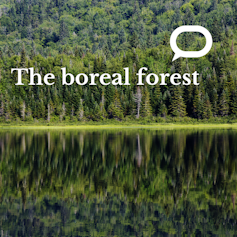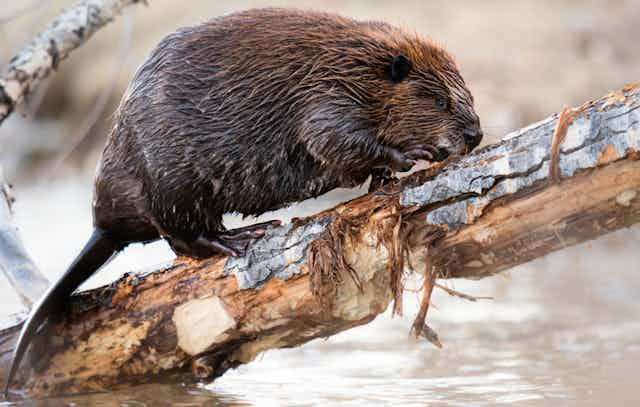While hiking near a river, chances are you’ve seen the tell-tale tree stumps with cone-shaped tips. Who carves these? A large, flat-tailed rodent called the Canadian beaver (Castor canadensis), who also happens to be the emblem of our country.

This article is part of La Conversation Canada’s series The boreal forest: A thousand secrets, a thousand dangers
La Conversation Canada invites you to take a virtual walk in the heart of the boreal forest. In this series, our experts focus on management and sustainable development issues, natural disturbances, the ecology of terrestrial wildlife and aquatic ecosystems, northern agriculture and the cultural and economic importance of the boreal forest for Indigenous peoples. We hope you have a pleasant — and informative — walk through the forest!
The beaver is the only animal species, other than humans, that is capable of felling a mature tree. In the boreal forest, it plays the role of an ecosystem engineer. In other words, beavers create new habitats by building dams that raise the water level. The impacts of these dams on the land can create headaches for many industries and owners of infrastructure.
We think we understand the disruptive presence of beavers on the forest quite well. But when it comes to handling the conflicts that beavers provoke in an ethical and sustainable way, we actually have a poor understanding of the dynamics of beavers’ occupation of the territory.
In order to delve deeper into these dynamics, we decided to conduct a study in Abitibi-Témiscamingue. The region has the highest density of beaver colonies in Québec, a province where the species abounds.
The goal of this master’s project in ecology, carried out as part of the work of the GRÉMA research group at the Université du Québec en Abitibi-Témiscamingue (UQAT), is to demystify the secrets of beavers, one of the key species of boreal forests.
Disruptive agents who make their presence known
The beaver lives at the intersection of the aquatic and forest environments, so its presence increases interactions between these two ecosystems. The beaver is also part and parcel of the natural disturbances that take place in the boreal forest. Beaver constructions influence the structure of plant stands and shape the heterogeneity of the landscape. The ponds that beavers create on rivers trap water, slow the current, fill groundwater reservoirs, protect the land from forest fires and increase biodiversity by creating new habitats that are suitable for many species.

Much of the composition of the boreal forest today is the result of a succession of plant species that thrived in the gaps (openings) in the canopy beavers left behind. Recently, land managers have been advocating in favour of a more ecosystem-based approach to forest management. This would involve incorporating simulations of disturbances, such as those created by beavers, into silviculture (forest management) plans.
When beavers are naturally present in an area, this approach makes it possible to take into account the history of local disturbances, which increase the resilience of forest stands to future disturbances.
Highly developed lodging
The beaver builds a lodge to protect itself from predators, for use as cover and to store food. It prefers gently sloping land with a soft substrate where the water level is stable and the flow rate low. Beavers live indoors in colonies of two to eight individuals of the same family.
Recent studies have shown that beaver colonies will occupy a single lodge for an average of two and a half years, and often have more than one lodge in their territory. Beavers use their different lodges according to their needs. For example, they will choose their lodge according to the location of seasonal resources present during the summer, such as aquatic plants, which they love.

We need to cut deeper
We know that this rodent feeds mainly on deciduous trees such as aspen, willow or oak. Since these trees are not always dominant in the boreal forest (which is populated by conifers such as black spruce, balsam fir and jack pine), it makes sense to ask questions about the rodent’s supply strategies in this type of forest.
Spatial use of the territory (called the area of influence) could vary according to the food resources available. It is also limited by the mobility of the animal and the threat of predators. In order to study this use, we will attempt to reconstruct the pattern of occupation and alternation of lodges of several beaver colonies.
Lack of knowledge on this subject owes partly to the fact that it is difficult to study an animal that is nocturnal, half-terrestrial and half-aquatic. Because of the beaver’s neck and tail shape, researchers cannot use telemetric collars to track their movements with antennae. We have therefore opted to observe them in the wild and use dendroecological data collection and stable isotope analysis, which we will be doing in the summer of 2023.
Dendroecology will provide us with temporal information about beaver lodges. This science, described as the study of annual plant growth rings in an ecological context, will be used to construct an occupancy profile of beaver lodges over time.
Using a sample of huts, we will cut all regenerated stump sprouts at the base of the hut following grazing of the main stem, also known as coppice, and count the number of annual rings. This will make it possible to date when these resources were consumed and thus, to define the period of occupation of the territory by a given colony, in one or several huts.

Our research will also use stable isotopes in a hundred or so carcasses recovered from trappers in the Abitibi region. Isotopes are widely used in ecology and can make it possible for researchers to reconstruct an animal’s diet. An isotope is an atom of a certain element that has a different number of neutrons than the atom found in its pure state, without altering its nature. The methods used are based on comparing the level of a given isotope found in the body to a reference level.
Carbon and nitrogen will be the focus of this study. Since each plant and organism has a unique isotopic signature (a ratio of carbon¹³ and nitrogen¹⁵), this method will allow us to identify the diet of the beaver. Specifically, we will be able to determine the different components of the beaver’s diet, their proportion and their general origin (i.e. whether they come from the terrestrial or aquatic environment). The isotopes also renew themselves at different rates depending on the tissue. We will therefore be able to match the diet to a certain time frame by testing different organs (liver, hair and muscles in this case).
An ally we shouldn’t scorn
Climate change shows us that the temperate forest is migrating northwards, leading to an increase in beaver habitats. We can therefore expect an increase in beaver populations. Since this phenomenon coincides with an expanding network of forest roads and human development, we need to arm ourselves with the knowledge necessary to be able to deal with the increased human-animal conflicts that could result.
The beaver provides important services to its ecosystem. It is a serious ally in the fight against climate change, providing us with a more stable water supply over time. Its habitat provides a refuge for many species. We have everything to gain by learning more about the beaver’s habitat selection strategies so that we can learn to co-exist with them in harmony.
The development of this knowledge will be a great asset when it comes to planning different types of infrastructure in boreal territory, where this rodent abounds.



